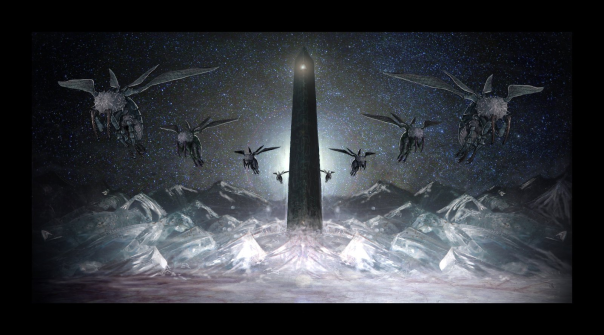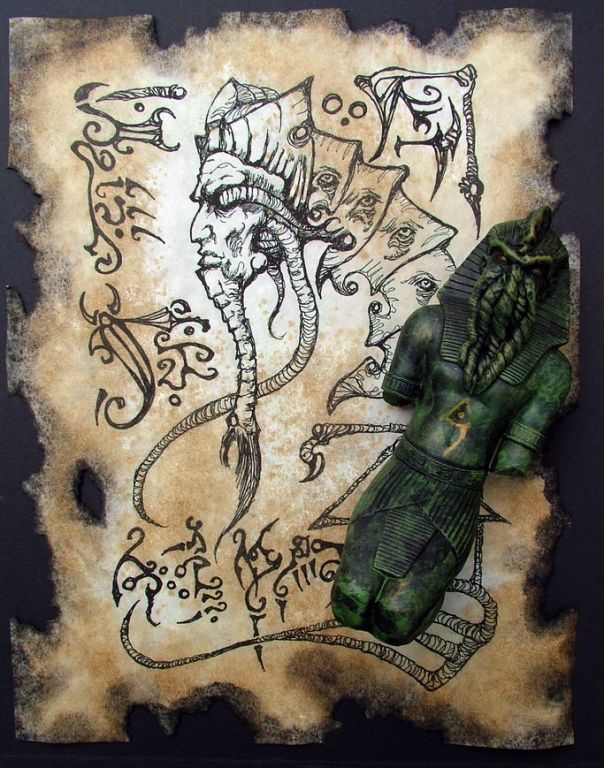As previously discussed there appears to be an established methodology in the operation of the Shining Trapezohedron in H.P. Lovecraft’s “The Haunter in the Dark.” First, the Haunter needs to get the attention of a sentient entity and this is conducted through the trapezohedron. When the Haunter detects the presence of a sentient entity recognizing or acknowledging the trapezohedron through some sensory method, some type of connection is made. In our case this sensory method is sight, with photons of light reaching the light sensitive cells in the retina of our eyes (rods and cones) and then sending neural impulses to our brain for recognition. For other entities, the sensory method may be associated with heat or sound or even X-rays. Once this inter-dimensional connection of perception is made, complete darkness is required. Thus, it behooves the Haunter to put fear and paranoia into the receiving entity, forcing them to close the box. This puts the trapezohedron into complete darkness, which is required for the Haunter to enter our Universe. More on this and the biology of the Haunter relative to light in a later article; this article will review some of the historical accounts that have involved the Shining Trapezohedron.
 Shining Trapezohedron
Shining Trapezohedron
In “The Haunter in the Dark” Lovecraft describes the Shining Trapezohedron as “…a window on all time and space…” Again, this supports the concept that the trapezohedron functions as both a mode of communication as well as transportation. Also, as previously mentioned, if the information or matter conveyed by the stone uses technology that is beyond that of our Space-Time, the limitations associated with the speed of light may not apply to its use. Thus, peering into the trapezohedron may not be the same as looking at a star or nebula in a telescope where we are also looking into the distance past. The trapezohedron may be a “real time” window through time, space and beyond.
The Shining Trapezohedron was fashioned on Yuggoth and according to S.T. Joshi this appears to establish some type of connection among the Haunter, Yuggoth and/or Nyarlathotep (Lovecraft and a World in Transition: Collected Essays on H.P. Lovecraft by S.T. Joshi; 2014). It is said that the Old Ones brought the Shining Trapezohedron to Earth; however, it is not known if the term “Old Ones” refers to the Fungi from Yuggoth – the Mi-Go – or some other species. As stated in “Out of the Aeons” by H.P. Lovecraft and Hazel Heald, the Yuggoth Spawn existed on the dwarf planet eons before the arrival of the Mi-Go. The Yuggoth Spawn brought and deposited their patron daemon Ghatanothoa into the deep crypts of the fortress Yaddith-Gho on Yuggoth. It is certainly possible that the Yuggoth Spawn also brought the Shining Trapezohedron to Yuggoth, which was subsequently discovered by the Mi-Go and then eventually taken to Earth. In fact, the Mi-Go may have attempted to utilize the Trapezohedron as a weapon in their war against the Elder Things.
 Yuggoth Watchtower by Chaberwood (www.deviantart.com). Was the Shining Trapezohedron housed in a structure like this on Yuggoth?
Yuggoth Watchtower by Chaberwood (www.deviantart.com). Was the Shining Trapezohedron housed in a structure like this on Yuggoth?
Eventually, the Elder Things possessed the Shining Trapezohedron. Once the stone was on Earth it was treasured and placed in a curious box by the crinoid things of Antarctica. This is obviously a reference to the Elder Things from At the Mountains of Madness.
The Haunter of the Dark goes on to document that the Shining Trapezohedron was salvaged from the ruins of the Elder Things (presumably from the Elder Things’ ancient cities in Antarctica) by the serpent-mean of Valusia (more on them in a future article). The first humans to gaze into the trapezohedron were from Lemuria and later from Atlantis. After the fall of the Atlantean civilization a Minoan fisherman found the stone in one of his nets and sold it to a merchant from “nighted Khem.”
It is said that the Pharaoh Nephren-Ka, also known as the Black Pharaoh, constructed an entire temple around the Shining Trapezohedron, placing it in a windowless crypt. Robert Bloch provides more information on the “atrocious sacrifices” Nephren-Ka did in his worship of Nyarlathotep (see Bloch’s story “Fane of the Black Pharaoh” in his book Mysteries of the Worm). Indeed, it is thought that Nyarlathotep gave Nephren-Ka the gift of prophecy and many of these prophecies were painted on the walls of the temple. Was this gift of prophecy simply Nephren-Ka harnessing the powers of observation associated with the Shining Trapezohedron? If the stone is a window of time and space, it could have easily been utilized as a means of predicting the future.
 Pharaoh Nephren-Ka the Black Pharaoh by Mr. Zarono (www.deviantart.com)
Pharaoh Nephren-Ka the Black Pharaoh by Mr. Zarono (www.deviantart.com)
Toward the end of “The Haunter of the Dark” Blake does say, “Is it not an avatar of Nyarlathotep, who in antique and shadowy Khem even took the form of man?” (H.P. Lovecraft). An avatar is a manifestation or representation of a deity or other entity. Thus, this is the connection that was cited by Joshi earlier in this article. Khem is simply one of the many names that the ancient people of Egypt called their country (Stephen S. Mehler; www.bibiotecapleyades.net). Also, if the Haunter is an avatar of Nyarlathotep, was Nephren-Ka another avatar of Nyarlathotep in ancient Khem?
As a result of his sacrifices, at least 100 documented victims, and the inter-dimensional power Nephren-Ka received from his dealings with Nyarlathotep through the Shining Trapezohedron, he was driven out of Khem, his name was stricken from history and all monuments to Nephren-Ka were destroyed. Next time we will discuss in more detail the relationship between the Black Pharaoh and Nyarlathotep and how Nephren-Ka used the Shining Trapezohedron. Thank you – Fred.
 Three-Lobed Burning Eye by Steve Purcell
Three-Lobed Burning Eye by Steve Purcell
1 thought on “A Brief History of the Shining Trapezohedron”